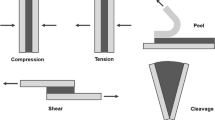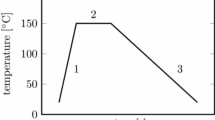Abstract
This paper investigates the use of coupon specimens to study the severity of defects in filament would tubes. Composites based on two types of resin are studied, an epoxy and a vinylester. First, the properties of the unreinforced resins are measured. Next the properties of flat filament wound unidirectional glass fibre reinforced composite plates using these resins are determined, and in particular their delamination resistance under mode I loading. These results are then compared with those determined on specimens taken from filament wound tubes with different winding angles (±30°, ±45° and ±60°) and diameters.
Similar content being viewed by others
References
Rolston, J. A., ‘Filament Winding’, inProcessing and Fabrication Technology, Delaware Composites Design Encyclopedia, Vol. 3, Ch. 3.II, Technomic, 1990, pp. 193–204.
Garvey, R. E.,Marine Technology and Science Journal 24(2), 1990, 49–58.
Croquette, J., Parquic, J. C., Forestier, J. M. and Dufour, X., ‘Composite Pipes: Prototype Piping System on a Fishing Boat’, in P. Davies, L. Lemoine, Ifremer (eds),Nautical Construction with Composite Materials, 1992, pp. 412–422.
Gibson, A. G., in R. A. Shenoi and J. F. Wellicome (eds),Composite Materials in Maritime Structures, Ch. 11, Cambridge Ocean Tech. Series, 1993.
Bigourdan, B., Chauchot, P., Hassim, A. and Lene, F., ‘Homogenisation for the Design of Cylindrical Containers Made of Composite Materials’, in D. Baptiste (ed.),Mechanics and Mechanisms of Damage in Composites and Multimaterials, ESIS 11, MEP London, 1991, pp. 203–212.
Kies, J. A. and Bernstein, H.,Proc. 17th SPI Conf. on Reinf. Plastics, 1962, Section 6B, 1–8.
ASTM D5528, Standard Test Method for Mode I Interlaminar Fracture Toughness of Continuous Fiber Reinforced Composite Materials, 1994.
ESIS Protocols for Delamination Testing of Composites under Mode I, Mode II and Mixed Mode Loading, 1992. Available from P. Davies, Ifremer.
Nicholls, D. J. and Gallagher, J. P., ‘Determination ofG Ic in Angle Ply Composites Using a Cantilever Beam Test Method’,J. Reinf. Plastics and Composites 2, 1983, 2–17.
Chai, H., ‘The Characterization of Mode I Delamination Failure in Non-Woven Multidirectional Laminates’,Composites 15, 1984, 277–290.
Goetz, D. P., ‘Determination of the Mode I Delamination Fracture Toughness of Multidirectional Composite Laminates’, PhD Thesis, Texas A&M University, 1988.
Robinson, P. and Song, D. Q., ‘A Modified DCB Specimen for Mode I Testing of Multidirectional Laminates’,J. Comp. Mats. 26(11), 1992, 1554–1577.
Laksimi, A., Benzegagh, M. L., Jing, G., Hecini, M. and Roelandt, J. M., ‘Model I Interlaminar Fracture of Symmetrical Cross-Ply Composites’,Comp. Sci. and Tech. 41, 1991, 147–164.
Riddle, R. A. and Beckwith, S. W., ‘Development of Test and Analysis Methods for Thick-Wall Graphite/Epoxy Filament-Wound Composite Materials Fracture Toughness’, in J. M. Whitney (ed.),ASTM STP 893, 1986, pp. 64–83.
Sparks, C. P., Odru, P. and Le Floc'h, C., ‘Composite Riser Tubes: Defect Tolerance Assessment and Nondestructive Testing’, inProc. 24th Annual Offshore Technology Conference, Houston, 1992, pp. 191–198.
Lagace, P. A. and Saeger, K. J., ‘Damage Tolerance Characteristics of Pressurized Graphite/Epoxy Cylinders’, inProc. 6th OMAE Symposium, Vol.III, 1987, pp. 31–37.
Davies, P. and Benzeggagh, M. L., ‘Interlaminar Mode-I Fracture Testing’, in K. Friedrich (ed.),Application of Fracture Mechanics to Composite Materials, Ch. 3, Elsevier Science Publishers, 1989.
Williams, J. G., A Linear Elastic Fracture Mechanics (LEFM) Standard for DeterminingK c andG c for Plastics, 1990.
Ciba Geigy Data Sheet on LY556/HY917, 1992.
Dow Chemicals, Derakane Vinyl Ester Resins. Product and Usage Guide.
Prel, Y. J., Davies, P., Benzeggagh, M. L. and de Charentenay, F. X., ‘Mode I and Mode II Delamination of Thermosetting and Thermoplastic Composites’, in P. A. Lagace (ed.),ASTM STP 1012, 1989, pp. 251–269.
Johnson, W. S. and Mangalgiri, P. D., ‘Investigation of Fiber Bridging in Double Cantilever Beam Specimens’,NASA Tech. Memo. 87716, 1986.
Wells, G. M., ‘A Preliminary Investigation Into Transverse Fracture of Unidirectional Fibre Composites’, Harwell report AERE-R11494, 1985.
Davies, P., Cantwell, W., Moulin, C. and Kausch, H. H., ‘A Study of the Delamination Resistance of IM6/PEEK Composites’,Comp. Sci. and Tech. 36, 1989, 153–166.
Davies, P., ‘Fracture of Marine Composites’, in E. Armanios (ed.),Interlaminar Fracture 2, Trans. Tech. Publications, 1995.
Ripling, E. J., Santner, J. S. and Crosley, P. B., ‘Fracture Toughness of Composite Adherend Adhesive Joints under Mixed Mode I and III Loading’,J. Materials Science 18, 1983, 2274–2282.
Hunston, D. L., ‘Composite Interlaminar Fracture: Effect of Matrix Fracture Energy’,Composite Tech. Review 6(4), 1984, 176–180.
Author information
Authors and Affiliations
Rights and permissions
About this article
Cite this article
Davies, P., Rannou, F. The effect of defects in tubes: Part 1. Mode I delamination resistance. Appl Compos Mater 1, 333–349 (1994). https://doi.org/10.1007/BF00568040
Received:
Accepted:
Issue Date:
DOI: https://doi.org/10.1007/BF00568040




